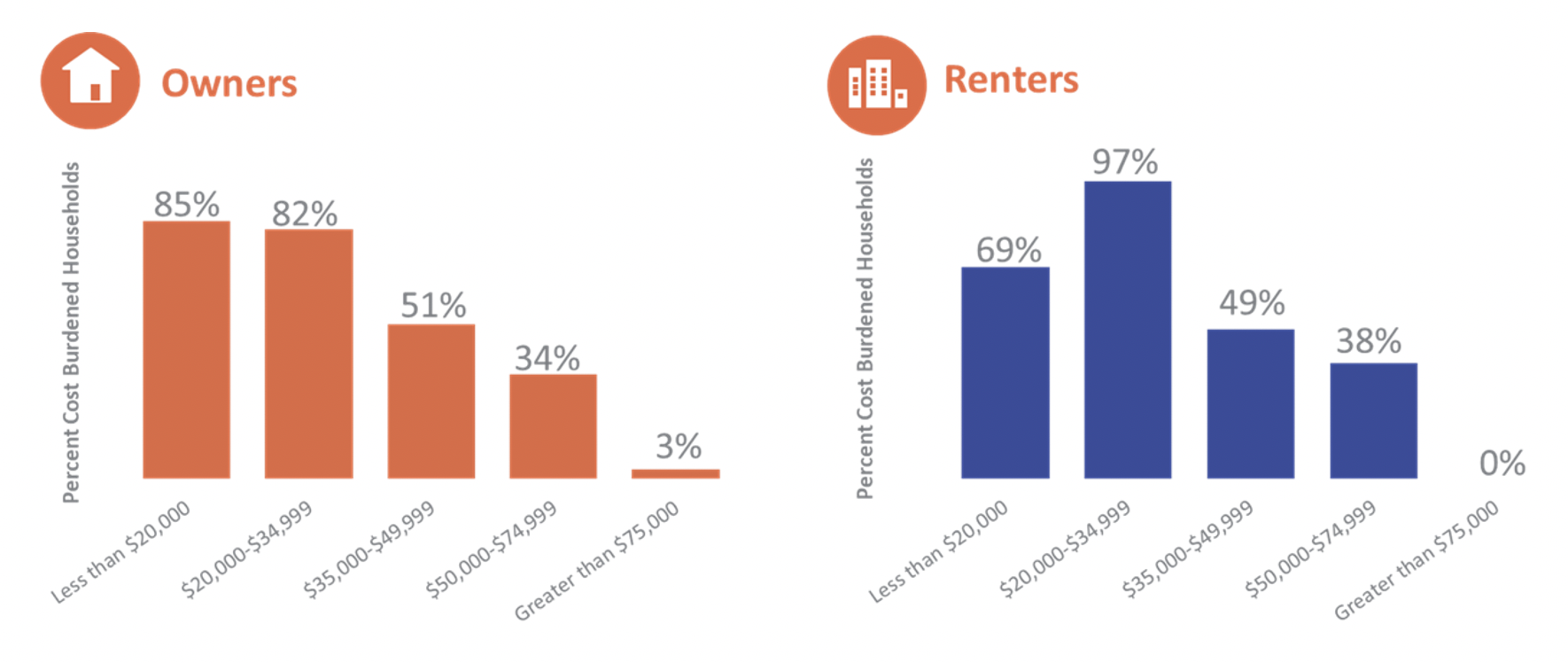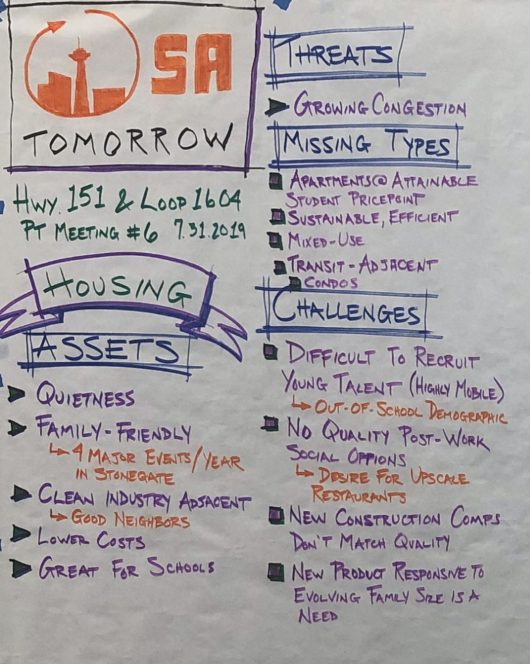Plan Framework
Housing
Housing Snapshot

The Highway 151 and Loop 1604 Area Regional Center has a population of 13,542 within 4,871 households. The plan area has experienced significant housing growth over the past two decades and has outpaced the city’s rate of growth, particularly between 2010 and 2018 when the area’s 4.9% annual growth rate was over four times the citywide average. While this represents strong growth of approximately 200 housing units per year since 2010, this is slower growth than the forecasted average annual increase to 2040. Between 2010 and 2040, the plan area is forecast to grow by 11,300 households.
Compared to the rest of San Antonio, households in the Regional Center are more likely to be family households with children. The majority of households (74%) are family households, which is higher than the citywide share. As a result, the average household size is greater in the Regional Center. The higher share of family households also results in a lower median age for the population in the plan area compared to the metropolitan region. The Regional Center’s median age is 32.7 years, compared to 34 years for San Antonio as a whole. Not only is there a higher share of children in the plan area, there is also a lower share of senior residents (those over the age of 65), which also contributes to the lower median age.
The Regional Center population has a higher rate of educational attainment than the citywide average and a higher average household income than the region as a whole. Of the plan area population aged 25 and older, only 6% have less than a high school diploma (compared to 18% in the city), and 52% have an Associate’s, Bachelor’s, or Graduate/Professional degree (compared to 34% in the city). The average household income in the Regional Center is $99,500, compared to $70,000 for the City of San Antonio.
The housing stock in the Highway 151 and Loop 1604 Area Regional Center is predominately single-family detached homes (72%). Prior to 2010, housing development in the Regional Center was mostly single-family homes. However, since 2010 the majority of new housing development has shifted toward multi-family housing. This is likely because the plan area has built-out and land for less dense housing products is limited.
In terms of housing tenure, the Highway 151 and Loop 1604 Area Regional Center has a similar proportion of owner-occupied housing units to that of the city overall. Slightly more than half (54%) of the homes in the Regional Center are owner-occupied, which is comparable to San Antonio’s owner-occupied rate of 53%. However, rental units have increased in the plan area in recent years.
Compared to Bexar County, housing costs for the Regional Center are higher. The average home list price for the plan area is $213,500 (as estimated by Zillow for the 78251 zip code area). However, newer homes built in the plan area since 2010 are selling for much higher amounts, ranging between $200,000 and $600,000. The average rental rate for an apartment in the plan area is $1,115 per month or $1.19 per square foot. This is higher than the countywide average of $952 per month and $1.11 per square foot. Since 2017, three projects in the area have been completed totaling over 700 multi-family units.
Highway 151 and Loop 1604 Area % of Cost Burdened Households by Income and Tenure, 2018

Despite higher than average housing costs in the Regional Center, there is a lower share of households that are cost-burdened than the Bexar County average. Cost burden is a measure of housing costs compared to income. Households that spend more than 30% of their income on housing are considered cost-burdened. Over one-third of renter occupied households in the study area (36%) are cost-burdened. This is lower than the Bexar County average (46%) and has been consistently lower since 2000. The rate of cost-burdened owner households (18%) is also less than the County average and has decreased since 2000. However, the share of cost-burdened households is not equal across incomes, with the vast majority of renters and owners in the Regional Center who earn less than $35,000 paying more than a third of their income toward housing. This measure indicates that residents of the Regional Center can, on average, afford area housing prices/rates. However, the rental rates and housing prices are significantly higher than rates that are affordable for much of the plan area’s workforce, especially workers in the retail or tourism industries.
Housing issues and strategies were primary topics of discussion at Community Meeting #2 and Planning Team Meeting #5, and were prominent topics of community and stakeholder input throughout the planning process. Community Meeting and Planning Team Meeting Summaries are available in the documents library of the Highway 151 and Loop 1604 Area Regional Center Plan webpage.
Housing Challenges in the Highway 151 and Loop 1604 Area Regional Center
During the plan process, the Highway 151 and Loop 1604 Area Planning Team members were asked to assess the Regional Center’s housing challenges during discussions at the two Planning Team meetings devoted to economic development and housing. Planning Team members were presented with relevant existing conditions data, and asked to qualitatively describe the plan area’s strengths and challenges. These conversations helped identify specific housing challenges that need to be addressed in the plan as well as missing housing types the plan can help encourage.
Highway 151 and Loop 1604 Area Planning Team Housing Challenges Analysis

The three main challenges in the Highway 151 and Loop 1604 Area Regional Center related to housing are:
- Managing Impacts of Growth:As the Regional Center continues to build out and as more people are living, working, and visiting the plan area, investments and efforts are needed to address the impacts of increased activity. Efforts such as congestion mitigation, alternative mobility options, access to parks and recreation, and others are needed to ensure that quality of life in the plan area is maintained.
- Housing Diversity:The Regional Center is a desirable place to live due to its housing stock, proximity to employment, quality schools, and overall natural aesthetic. However, the housing stock is predominately split between two options: larger single-family detached homes or luxury multi-family apartments. A greater diversity of housing is needed to support retention of empty nesters and seniors, to attract younger workforce to the plan area, and to provide options for current workers in the plan area to live closer to their place of work.
- Community Gathering Destinations:The Highway 151 and Loop 1604 Area Regional Center lacks community amenities and gathering places that are open and accessible to all residents, workers, and visitors. Several of the plan area neighborhoods have private community amenities that do support community events and gatherings. However, these spaces are largely only open to residents of specific neighborhoods, and not publicly accessible. Therefore, there is a need for more public open spaces and gathering destinations.
![]()
Housing Recommendations
Housing recommendations were developed based on the Highway 151 and Loop 1604 Area’s vision and goals, existing conditions data, and to address the challenges identified during the planning process. Specific strategies to implement these recommendations can be found in the Implementation section of the plan.
